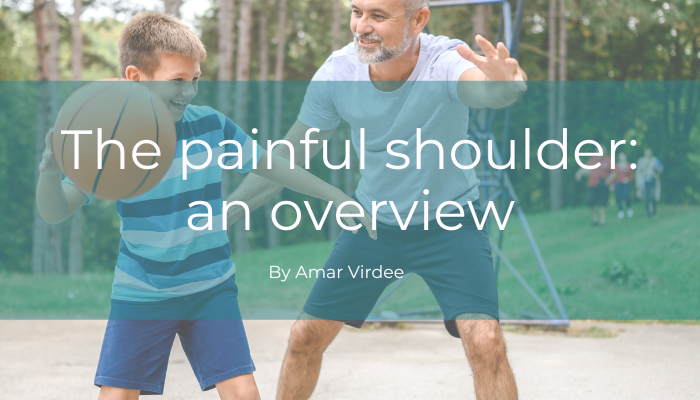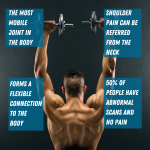The Shoulder: an overview

The shoulder is a ball and socket joint. Its structure and form mean that it allows for many different movements, making it the most mobile joint in the body! The socket is pretty shallow but this allows us not only to complete day-to-day activities like washing our hair but also allows us to participate in overhead sports like tennis and cricket. Here at Vitality Physio, shoulder injuries are one of the most common injuries that we see. But first, some anatomy:
Shoulder anatomy
Your shoulder is made up of three bones: your upper arm bone (humerus), your shoulder blade (scapula), and your collarbone (clavicle). The shoulder joint is actually where the ball of the humerus meets the rounded shallow socket of the scapula, called the glenoid. The muscles of the rotator cuff keep the large head of the humerus, positioned and centered in the glenoid. Doing so, helps to keep the most mobile joint in the body moving optimally!
So, what are the common causes of Shoulder Pain?
The shoulder is a complex joint, but fear not, with the right approach rehab needn’t be overwhelming! Overusing or underusing muscles and tendons can cause pain. Too much too soon, boom and bust are often the biggest culprits! Irritation to the bursae (the fluid-filled sac under bones or tendons) is very common and can be painful, even disturbing your sleep at night. Age-related injuries such as frozen shoulder or rotator cuff tears can cause pain too. They can rob you of movement and limit your function! Sometimes impact injuries and dislocations cause immense pain and damage to ligaments. Occasionally, shoulder pain may be referred from a nearby structure like an irritated nerve in the neck.
Every body is different and therefore every injury can present and have an impact on life in many different ways. A tendon injury for example may prevent someone from participating in sport, whereas a frozen shoulder can prevent someone from getting dressed in the morning. No matter the cause of injury, it is important to establish the cause. It helps prevent further injury, and will limit further longer-term issues too. Why leave it to chance?
What should I do if I have shoulder pain?
Distinguishing what is causing the pain, will impact your rehab. Sometimes, shoulder pain can be a result of an underlying illness such as diabetes or cardiac issues. Your Physio will flag the symptoms associated with causes other than the structures of the shoulder, and refer you to the right medical professional as needed.
If you have sudden crushing pain in your shoulder, call 999 straight away! If the pain runs from your chest to the left jaw, arm, or neck, or occurs with shortness of breath, dizziness, or sweating.
Do I need a scan of my shoulder? Why?
A thorough examination of the shoulder, alongside a detailed history of the injury, will often provide the most information required for our Physios to make a diagnosis. MRI scans are not always needed. In fact, a study in 2014 showed that MRI scans showed changes and pathology in both symptomatic and asymptomatic shoulders. It also demonstrated that symptoms may not match the MRI findings. The notable financial burden of ordering MRI scans and the pertinency of the findings are therefore sometimes questionable. This does not mean that you will never need a scan, however, this should be done to either confirm a diagnosis, rule out dangerous pathology, or if you have failed conservative therapies for a reasonable amount of time.

What can you expect from Physiotherapy?
Your Physio will offer you a tailor-made plan, based on the problems you have and the goals you’d like to achieve. Maybe you’d like to play tennis again, go bouldering or even the simple everyday activities such as getting your arm into a coat or reaching a high shelf. We are all different, so why should your treatment be exactly the same? The primary principles of our problem-solving treatments however, will all resonate with any shoulder condition that you may have. They are the mainstays of quality Physiotherapy, including education about injury, modified training, adequate strength work, restoring function, and returning safely to sport.
It’s really important to load and train the shoulder, even when pain and dysfunction are resolved. This should include a combination of strength and mobility work. Train the shoulder muscles from the famous rotator cuff, deltoids, and traps as well as the scapular and spinal muscles.
What can you do now?
If you are experiencing shoulder pain, come and see us, we will help you understand what exactly is going on. Don’t let the pain hinder you any longer. Let us help you with a tailored rehab program specific to your injury and goal.
